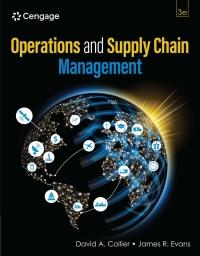Dont underestimate Amazon. They dont tell you what they are doing until its done. Amazon delivers packages,
Question:
“Don’t underestimate Amazon. They don’t tell you what they are doing until it’s done.” Amazon delivers packages, groceries, and restaurant orders to homes, businesses, Amazon Lockers, and even cars worldwide. Amazon has been a global innovator in logistics for more than a decade. In 2009, they introduced same-day deliveries. In 2013, Operation Dragon Boat was launched. This was a strategy for building an international shipping and logistics company that focused on owning the entire supply chain from product sourcing, warehousing, and down to the last mile. In 2015, they built 58 delivery hubs across the United States to create a cost-efficient last-mile delivery system called Prime Now and sortation centers for small package delivery, allowing the company to use the less-expensive U.S. Postal Service. In 2018, Amazon launched Amazon Logistics, its lastmile delivery services. Soon after, they began to offer free one-day deliveries, and introduced the Amazon Robotics Program for last-mile delivery solutions. One example of this program is a six-wheeled robot called Scout that delivers groceries, pharmaceuticals, and other items straight to a customer’s door. For a company like Amazon, the last mile of delivery is critical and provides a competitive edge over its competitors. The last mile network is powered by hundreds of small businesses and tens of thousands of drivers that leverage Amazon technology. The Last Mile Technology team develops solutions such as mapping and navigation programs, analyticsbased routing and planning algorithms, IoT and hardware innovations, and mobile apps for consumers. A less-technical supply chain innovation includes building their own 53-feetlong shipping containers instead of the standard 20- and 40-feet-long containers. The longer and higher capacity containers better use the capabilities of semitrucks. Amazon continues to innovate at all levels of its supply chain using technology. For instance, it plans to convert its Whole Foods and Amazon Fresh grocery stores to allow the customer to simply walk into the store and put items in a cart or bag. Customers can then exit the store, and an Amazon smartphone app charges the customer for the items. There are no checkout lanes or cash registers. Prior to 2020 in Florida, Amazon operated 29 warehouses and logistical facilities. Florida’s online orders had grown at double digit percentages; however, the pandemic ramped up demand. In 2020, first-quarter revenues jumped 26 percent because Amazon provided essential products while people stayed at home. But the surge in demand from Florida customers resulted in lengthy delivery delays. Amazon’s objective is to shorten delivery times for Florida’s 22 million residents. Same day or next day delivery is the goal for all items ordered online. To meet these needs, Amazon plans to expand to over 55 facilities and 16 million square feet of warehouse space by the mid-2020s. The facilities include fulfillment centers, sorting centers, and last-mile delivery stations. If you add over 30 Whole Food stores that Amazon owns, several Amazon 4-star stores, and Amazon Pharmacies, the number of facilities and locations in Florida will easily exceed 100. Amazon’s growth in Florida has created over 60,000 new jobs and billions of dollars in new construction. “In addition to our own Amazon employees in Florida, our facilities have created over 90,000 indirect jobs,” Owen Torres, a spokesperson for Amazon, told reporters. As we noted in the box on Supply Chains to Admire in this chapter, the best supply chain wins!
Case Questions for Discussion:
1.Research the economics of supply chains. For example, what is the cost of the “last mile”? How much does Amazon save over competitive shippers like UPS and FedEx from its supply chain strategy? Summarize your finding in one typed page or less.
2.What are the challenges that companies face in implementing last-mile delivery efforts? What does Amazon’s strategy mean for brick-and-mortar retailers? Does Amazon help or hurt small business? Explain in two typed pages or less.
Step by Step Answer:

Operations And Supply Chain Management
ISBN: 9780357901649
3rd Edition
Authors: David A. Collier; James Evans





